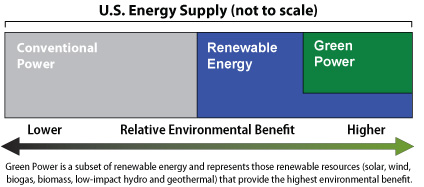Green Power Market

Green Power Market
Green Power Defined
Renewable energy and green power — what’s the difference?
In short, not all sources of power generation have the same environmental benefits and costs.
Green power is a subset of renewable energy (Graph 1) and represents those renewable energy resources and technologies that provide the highest environmental benefit. EPA defines green power as electricity produced from solar, wind, geothermal, biogas, biomass, and low-impact small hydroelectric sources. Customers often buy green power for avoided environmental impacts and its greenhouse gas reduction benefits.

Green power sources produce electricity with an environmental profile superior to conventional power technologies and produce no anthropogenic (human caused) greenhouse gas emissions. EPA requires that green power sources must also have been built since the beginning of the voluntary market (1/1/1997) in order to support “new” renewable energy development.
Renewable energy includes resources that rely on fuel sources that restore themselves over short periods of time and do not diminish. Such fuel sources include the sun, wind, moving water, organic plant and waste material (biomass), and the earth’s heat (geothermal). Although the impacts are small, some renewable energy technologies have an impact on the environment. For example, large hydroelectric resources can have environmental trade-offs associated with issues such as fisheries and land use.
Conventional power includes the combustion of fossil fuels (coal, natural gas, and oil) and the nuclear fission of uranium. Fossil fuels have environmental costs from mining, drilling, or extraction, and emit greenhouse gases and air pollution during combustion. Although nuclear power generation emits no greenhouse gases during power generation, it does require mining, extraction, and long-term radioactive waste storage.
Type of emissions
Anthropogenic emissions are produced as a result of human activity that unnaturally releases CO2 emissions into the atmosphere. One of the largest sources of anthropogenic CO2 emissions is the combustion of fossil fuels or fossil fuel-based products to produce electricity.
Biogenic emissions, in contrast, result from natural biological processes, such as the decomposition or combustion of vegetative matter. Biogenic emissions are part of a closed carbon loop. Biogenic CO2 emissions are balanced by the natural uptake of CO2 by growing vegetation, resulting in a net zero contribution of CO2 emissions to the atmosphere. Examples of biogenic emission sources include burning vegetation (biomass) to produce electricity or using plant-based biofuels for transport.
![[logo] US EPA](https://webarchive.library.unt.edu/eot2008/20081106012804im_/http://www.epa.gov/epafiles/images/logo_epaseal.gif)